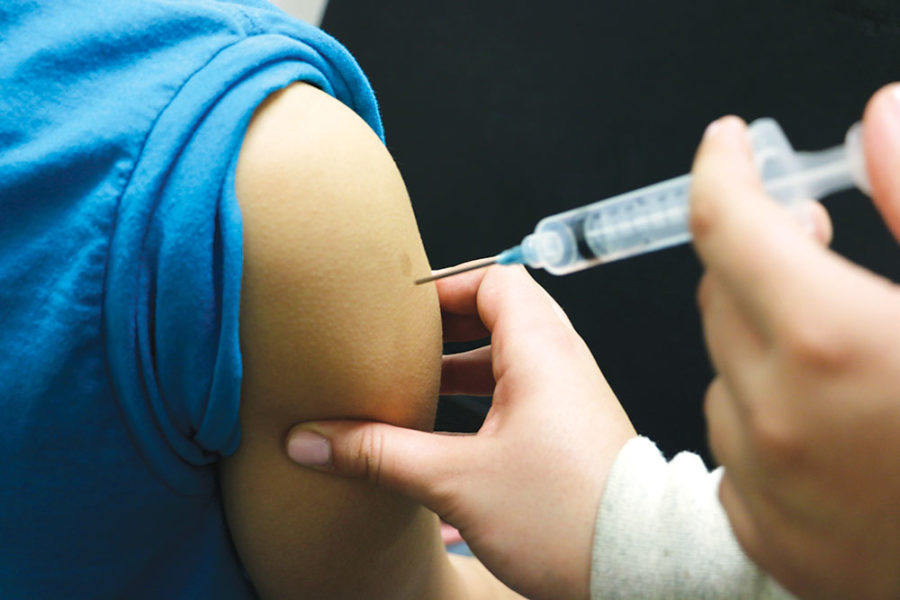With over 5,000 students, CHS is the largest public high school in Indiana and one of the largest in the nation. But while this school’s large student body has its benefits, for students like sophomore Raymond “Ray” Mo, it can sometimes feel more like a curse than a blessing during flu season. Mo said coming into contact with so many different people during the school day may have led him to fall ill last month, especially as temperatures dropped and the flu season reached its peak.
 “I got sick early in the week (in January) and ended up getting a really bad fever, and I considered staying home from school,” Mo said. “I think lack of sleep was a major cause of me getting sick, but what also definitely played a factor was the fact that I came in contact with so many people that I might have been more susceptible to getting an illness.”
“I got sick early in the week (in January) and ended up getting a really bad fever, and I considered staying home from school,” Mo said. “I think lack of sleep was a major cause of me getting sick, but what also definitely played a factor was the fact that I came in contact with so many people that I might have been more susceptible to getting an illness.”
According to Kandyce Hardie, school nurse and district nurse coordinator, larger schools like CHS are more vulnerable to the spread of diseases like the flu simply due to the sheer number of people congregated in one building.
“Viral illnesses, especially, are spread by either being airborne, with something lingering in the air, or by touch contact; so in a school this large, obviously the more students you have, the higher chance of illness you’re going to have,” Hardie said. “Of course, it’s in the community, and it’s when you go to stores and you touch shopping carts and door handles, and anywhere someone touches, you have potential to be exposed (to the flu). I would say we have an increased threat just because our school is bigger than other schools, but our custodians do a great job of cleaning, and we try to prevent those things from happening.”

Cole Beeler, director of infection prevention at the Indiana University Hospital, also said large public buildings such as airports, museums and schools are more subject to the spread of disease than other places. According to Beeler, the flu virus can travel up to six feet through respiratory secretions.
Hardie said she has noticed an increase in the spread of disease at this school during the colder months, which is when flu season usually begins.
“Typically, when the school year starts, (the school nurses) don’t see a lot of students, and (the number of ill students) starts to pick up around the holidays,” Hardie said. “Right now, we’re probably seeing at least 150 students a day between the two health centers. Some of those are for students who take daily medication, but there are students who are ill as well.”
Mo also said he saw more students and staff getting sick during the holidays, specifically during finals week.
While getting the flu shot may appear to be an obvious solution to preventing the flu, nearly half of Americans do not receive it. According to a survey conducted by the University of Chicago, a lack of confidence in the effectiveness of the flu shot and worries about the side effects of it led to 41 percent of Americans not getting a vaccination this flu season.
Despite this, however, both Beeler and Hardie said they recommend that all students and staff get the flu shot because the vaccination protects not only the person receiving it but also others around them. Beeler said the only exception to this is if someone has had a severe, life-threatening reaction to the flu shot in the past. Moreover, contrary to popular belief, Beeler also said people cannot get sick from receiving the flu shot because it lacks a live virus.
Mo, who receives a flu shot annually, said he agrees that others who are healthy enough should be vaccinated as well.
Mo said, “If (everyone at CHS) got the flu shot, fewer people would get sick because they’d build greater immunity, and that really helps, especially in a larger school.”
In regard to the efficacy of the flu shot, Beeler and Hardie said this will vary year to year due to the fact that it is a prediction based on past flu seasons and also said it is important to keep in mind that the flu shot does not protect people from all illnesses.
“There are a lot of viruses circulating right now, but not all of them are the flu,” Beeler said via email. “Most people call any viral infection ‘the flu,’ but really, it’s a very specific illness caused by the influenza virus. It’s important to differentiate because people often say ‘that flu vaccine didn’t work’ after they get a viral infection that they blame on being influenza, but was actually another virus.”
According to Beeler, there is no way to tell how effective the shot will be this flu season until it has ended, but the effectiveness is typically around 50 percent.
“Fifty percent might not seem great,” Beeler said. “If it were a test score it would be a failing grade, but I like to think of the flu shot like a seat belt. Even if you knew that a seat belt was only 50 percent effective at saving your life during a crash, you would still drive with one because 50 percent is better than zero percent.”



















![Joseph Broman, Mu Alpha Theta sponsor, grades tests for his honors precalculus/trigonometry class. Broman said, “I’m retiring from the Math Club next year and I’m just going to do Mu Alpha Theta so I can focus on that one and we can do more [speaker series] first semester.”](https://hilite.org/wp-content/uploads/2024/03/IMG_9502-1200x900.jpg)











![British royalty are American celebrities [opinion]](https://hilite.org/wp-content/uploads/2024/03/Screenshot-2024-03-24-1.44.57-PM.png)




















![Review: “The Bear” sets an unbelievably high bar for future comedy shows [MUSE]](https://hilite.org/wp-content/uploads/2024/03/unnamed.png)
![Review: “Mysterious Lotus Casebook” is an amazing historical Chinese drama [MUSE]](https://hilite.org/wp-content/uploads/2024/03/0.webp)
![Thea Bendaly on her Instagram-run crochet shop [Biz Buzz]](https://hilite.org/wp-content/uploads/2024/03/IMG_0165-1200x838.jpg)
![Review: Sally Rooney’s “Normal People,” is the best book to read when you are in a time of change [MUSE]](https://hilite.org/wp-content/uploads/2024/03/20047217-low_res-normal-people.webp)
![Review: “One Day” broke me for the second time, but this time it hurt worse [MUSE]](https://hilite.org/wp-content/uploads/2024/03/unnamed-8.png)
![Review in Print: Maripaz Villar brings a delightfully unique style to the world of WEBTOON [MUSE]](https://hilite.org/wp-content/uploads/2023/12/maripazcover-1200x960.jpg)
![Review: “The Sword of Kaigen” is a masterpiece [MUSE]](https://hilite.org/wp-content/uploads/2023/11/Screenshot-2023-11-26-201051.png)
![Review: Gateron Oil Kings, great linear switches, okay price [MUSE]](https://hilite.org/wp-content/uploads/2023/11/Screenshot-2023-11-26-200553.png)
![Review: “A Haunting in Venice” is a significant improvement from other Agatha Christie adaptations [MUSE]](https://hilite.org/wp-content/uploads/2023/11/e7ee2938a6d422669771bce6d8088521.jpg)
![Review: A Thanksgiving story from elementary school, still just as interesting [MUSE]](https://hilite.org/wp-content/uploads/2023/11/Screenshot-2023-11-26-195514-987x1200.png)
![Review: When I Fly Towards You, cute, uplifting youth drama [MUSE]](https://hilite.org/wp-content/uploads/2023/09/When-I-Fly-Towards-You-Chinese-drama.png)
![Postcards from Muse: Hawaii Travel Diary [MUSE]](https://hilite.org/wp-content/uploads/2023/09/My-project-1-1200x1200.jpg)
![Review: Ladybug & Cat Noir: The Movie, departure from original show [MUSE]](https://hilite.org/wp-content/uploads/2023/09/Ladybug__Cat_Noir_-_The_Movie_poster.jpg)
![Review in Print: Hidden Love is the cute, uplifting drama everyone needs [MUSE]](https://hilite.org/wp-content/uploads/2023/09/hiddenlovecover-e1693597208225-1030x1200.png)
![Review in Print: Heartstopper is the heartwarming queer romance we all need [MUSE]](https://hilite.org/wp-content/uploads/2023/08/museheartstoppercover-1200x654.png)























![Review: Ladybug & Cat Noir: The Movie, departure from original show [MUSE]](https://hilite.org/wp-content/uploads/2023/09/Ladybug__Cat_Noir_-_The_Movie_poster-221x300.jpg)

![Review: Next in Fashion season two survives changes, becomes a valuable pop culture artifact [MUSE]](https://hilite.org/wp-content/uploads/2023/03/Screen-Shot-2023-03-09-at-11.05.05-AM-300x214.png)
![Review: Is The Stormlight Archive worth it? [MUSE]](https://hilite.org/wp-content/uploads/2023/10/unnamed-1-184x300.png)




